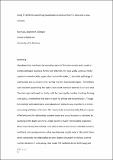Files in this item
Using RT qPCR for quantifying Mycobacteria marinum from in vitro and in vivo samples
Item metadata
| dc.contributor.author | Xaio, Han | |
| dc.contributor.author | Gillespie, Stephen H | |
| dc.contributor.editor | Gillespie, Stephen | |
| dc.date.accessioned | 2019-01-11T00:30:52Z | |
| dc.date.available | 2019-01-11T00:30:52Z | |
| dc.date.issued | 2018 | |
| dc.identifier | 252482706 | |
| dc.identifier | f8554d00-af41-4ac1-b3cd-e3bb7b99d43d | |
| dc.identifier | 29322466 | |
| dc.identifier | 85040695699 | |
| dc.identifier | 000431336200014 | |
| dc.identifier.citation | Xaio , H & Gillespie , S H 2018 , Using RT qPCR for quantifying Mycobacteria marinum from in vitro and in vivo samples . in S Gillespie (ed.) , Antibiotic Resistance Protocols . Methods in Molecular Biology , vol. 1736 , Humana Press/Springer , New York, NY , pp. 137-145 . https://doi.org/10.1007/978-1-4939-7638-6_13 | en |
| dc.identifier.isbn | 9781493976362 | |
| dc.identifier.isbn | 9781493976386 | |
| dc.identifier.issn | 1064-3745 | |
| dc.identifier.other | ORCID: /0000-0001-6537-7712/work/42023882 | |
| dc.identifier.uri | https://hdl.handle.net/10023/16843 | |
| dc.description.abstract | Mycobacterium marinum, the causative agent of fish tuberculosis, is rarely a human pathogen causing a chronic skin infection. It is now wildely used as a model system in animal models, especially in zebra fish model, to study the pathology of tuberculosis and as a means of screening new anti-tuberculosis agent. To facilitate such research, quantifying the viable count of M. marinum bacteria is a crucial step. The main approach used currently is still by counting the number of colony forming units (cfu), a method that has been in place for almost 100 years. Though this method well established, understood and relatively easy to perform, it is time-consuming and labor-intensive. The result can be compromised by failure to grow effectively and the relationship between count and actual numbers is confused by clumping of the bacteria where a single colony is made from multiple organisms. More importantly, this method is not able to detect live but not cultivable bacteria, and there is increasing evidence that mycobacteria readily enter a "dormant" state which confounds the relationship between bacterial number in the host and the number detected in a cfu assay. DNA based PCR methods detect both living and dead organisms but here we describe a method, which utilizes species specific Taq-Man assay and RT-qPCR technology for quantifying the viable M. marinum bacterial load by detecting 16S ribosomal RNA (16S rRNA). | |
| dc.format.extent | 9 | |
| dc.format.extent | 677229 | |
| dc.language.iso | eng | |
| dc.publisher | Humana Press/Springer | |
| dc.relation.ispartof | Antibiotic Resistance Protocols | en |
| dc.relation.ispartofseries | Methods in Molecular Biology | en |
| dc.subject | QH301 Biology | en |
| dc.subject | RM Therapeutics. Pharmacology | en |
| dc.subject | SDG 3 - Good Health and Well-being | en |
| dc.subject.lcc | QH301 | en |
| dc.subject.lcc | RM | en |
| dc.title | Using RT qPCR for quantifying Mycobacteria marinum from in vitro and in vivo samples | en |
| dc.type | Book item | en |
| dc.contributor.institution | University of St Andrews. School of Medicine | en |
| dc.contributor.institution | University of St Andrews. Infection and Global Health Division | en |
| dc.contributor.institution | University of St Andrews. Global Health Implementation Group | en |
| dc.contributor.institution | University of St Andrews. Gillespie Group | en |
| dc.contributor.institution | University of St Andrews. Biomedical Sciences Research Complex | en |
| dc.contributor.institution | University of St Andrews. Infection Group | en |
| dc.identifier.doi | 10.1007/978-1-4939-7638-6_13 | |
| dc.date.embargoedUntil | 2019-01-11 |
This item appears in the following Collection(s)
Items in the St Andrews Research Repository are protected by copyright, with all rights reserved, unless otherwise indicated.

